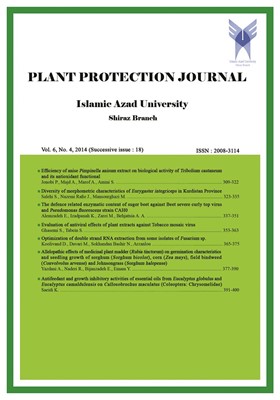Antifeedant and growth inhibitory activities of essential oils from Eucalyptus globulus and Eucalyptus camaldulensis on Callosobruchus maculatus (Coleoptera: Chrysomelidae)
محورهای موضوعی : گیاه پزشکی
1 -
کلید واژه:
چکیده مقاله :
The cowpea seed beetle, Callosobruchus maculatus (Fab.) (Coleoptera: Chrysomelidae: Bruchinae) is one of the major pests infesting stored pulses and is distributed worldwide. In this research, efficiency of plant extracts from Eucalyptus globulus Labill. and Eucalyptus camaldulensis Dehnh. were tested against the cowpea seed beetle for its antifeedant activity. Several experiments were designed to measure the nutritional indices such as relative growth rate (RGR), Relative consumption rate (RCR), efficiency of conversion of ingested food (ECI) and feeding deterrence index (FDI). Treatments were evaluated using a flour disk bioassay in the dark, at 27±1°C and 65±5% relative humidity concentrations of 0, 100, 500, 750, 1000, and 1500 mg/l were prepared from each essential oil and 10 adult insects were introduced into each treatment. After 72 h, nutritional indices were calculated. E. globulus oils were more effective than E. camaldulensis oils, by significantly decreasing the RGR, RCR and ECI. Both of plant essential oils, with the same activity, increased FDI as the oil concentration was increased, showing high feeding deterrence activity against C. maculatus. Generally, antifeedant activity of E. globulus was more effective than E. camaldulensis.

